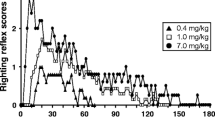Abstract
A simple and rapid method for detecting the behavioral effects of phencyclidine and related dissociative anesthetics is described. Dissociative anesthetics such as phencyclidine (PCP) and dizolcipine, which bind with high affinities at N-methyl-D-aspartate (NMDA) coupled cation channels (“PCP receptors”), produced a dose-related increase in the percentage of mice that fell from a 1.5 cm deep circular arena mounted on a 60 cm platform. A similar behavior was not manifest by other classes of compounds examined including competitive NMDA antagonists, an antagonist at strychnine-insensitive glycine receptors, and σ-receptor ligands with moderate to low affinities for PCP receptors. Pretreatment of mice with glycine reduced in a dose-dependent manner the percentage of falls elicited by a maximally effective dose of dizolcipine. This simple procedure may prove useful for both the rapid detection of dissociative anesthetics and evaluation of putative PCP antagonists.
Similar content being viewed by others
References
Balster R (1980) The effects of phencyclidine and three analogues on motor performance in mice. Pharmacology 20:46–51
Bennett D, Amrick C (1986) 2-Amino-7-phosphonoheptanoic acid (AP7) produces discriminative stimuli and anticonflict effects similar to diazepam. Life Sci 39:2455–2461
Choi D (1988) Glutamate neurotoxicity and diseases of the nervous system. Neuron 1:623–634
Contreras P (1990)D-Serine antagonized phencyclidine and MK-801-induced stereotyped behavior and ataxia. Neuropharmacology 29:291–293
Deutsch S, Mastropaolo J, Schwartz B, Rosse R, Morihisa J (1989) A “glutamatergic hypothesis” of schizophrenia. Clin Neuropharmacol 12:1–13
Goldman M, Jacobson A, Rice K, Paul S (1985) Differentiation of [3H]phencyclidine and (+)-[3H]SKF-10,047 binding sites in rat cerebral cortex. FEBS Lett 190:333–336
Jackson A, Sanger D (1988) Is the discriminative stimulus produced by phencyclidine due to an interaction with N-methyl-D-aspartate receptors? Psychopharmacology 96:87–92
Johnson K, Jones S (1990) Neuropharmacology of phencyclidine: basic mechanisms and therapeutic potential. Annu Rev Pharmacol Toxicol 30:707–750
Keana J, Scherz M, Quarum M, Sonders M, Weber E (1988) Synthesis and characterization of a radiolabelled derivative of the phencyclidine/N-methyl-D-aspartate receptor ligand (+)MK-801 with high specific radioactivity. Life Sci 43:965–973
Koek W, Woods J, Jacobsen A, Rice K (1987) Phencyclidine-like behavioral effects in pigeons induced by systemic administration of the excitatory amino acid antagonist, 2-amino-5-phosphonovalerate. Psychopharmacology 93:437–441
Koek W, Woods J, Winger G (1988) MK-801, a proposed noncompetitive antagonist of excitatory amino acid neurotransmission, produces phencyclidine-like behavioral effects in pigeons, rats and rhesus monkeys. J Pharmacol Exp Ther 245:969–974
Leander J, Wood C, Zimmerman D, dykstra L (1986) Phencyclidine-type catalepsy in the pigeon: an update on Chen's work. Drug Dev Res 7:75–85
Martin D, Lodge D (1988) Phencyclidine receptors and N-methyl-D-aspartate antagonism: electrophysiologic data correlates with known behaviors. Pharmacol Biochem Behav 31:279–286
Marwaha J, Palmer M, Hoffer B, Freedman R, Rice K, Paul S, Skolnick P (1981) Differential electrophysiological and behavioral responses to optically active derivatives of phencyclidine. Naunyn-Schmiedeberg's Arch Pharmacol 315:203–209
Mendelsohn L, Kerchner G, Kalra V, Zimmerman D, Leander D (1984) Phencyclidine receptors in rat cortex. Biochem Pharmacol 33:3529–3535
Olney J (1989) Excitatory amino acids and neuropsychiatric disorders. Biol Psychiatry 26:505–525
Rogawski M, Thurkauf A, Rice K, Jacobsen A, French-Mullen J (1988) Anticonvulsant activity of phencyclidine analogs: structural modifications resulting in enhanced seizure protection relative to motor side effect. In: Cavalheiro E, Lehmann J, Turdki L (eds) Frontiers in excitatory amino acid research. Liss, New York, pp 227–230
Shannon H (1983) Discriminative stimulus effects of phencyclidine: structure-activity relationships. In: Kamenka J, Domino E, Geneste P (eds) Phencyclidine and related arylcyclohexylamines: present and future applications. NPP Books, Ann Arbor, pp 311–335
Skolnick P, Marvizon J, Jackson B, Monn J, Rice K, Lewin A (1989) Blockade of N-methyl-D-aspartate induced convulsions by 1-aminocyclopropanecarboxylates. Life Sci 45:1647–1655
Thurkauf A, Mattson M, Jacobson A, Rice K (1988) Synthesis of a molecular hybrid of phencyclidine and dexoxadrol. In: Domino E, Kamenka J (eds) Sigma and phencyclidine-like compounds as molecular probes in biology. NPP Books, Ann Arbor, pp 47–54
Toth E (1988) Studies on the inhibition of phencyclidine-induced hyperactivity by glycine in mice. In: Domino E, Kamenka J (eds) Sigma and phencyclidine-like compounds as molecular probes in biology. NPP Books, Ann Arbor, pp 483–491
Toth E, Lajtha A (1986) Antagonism of phencyclidine-induced hyperactivity by glycine in mice. Neurochem Res 11:393–400
Tricklebank M, Singh L, Oles R, Wong E, Iversen S (1987) A role for receptors of N-methyl-D-aspartic acid in the discriminative stimulus properties of phencyclidine. Eur J Pharmacol 141:497–501
Trullas R, Skolnick P (1990) Functional antagonists at the NMDA receptor complex exhibit antidepressant actions. Eur J Pharmacol 185:1–10
Vincent J, Kartalovski B, Geneste P, Kamenka J, Lazdunski M (1979) Interaction of phencyclidine (“angel dust”) with a specific receptor in rat brain membranes. Proc Natl Acad Sci USA 76:4678–4682
Waziri R (1988) Glycine therapy of schizophrenia. Biol Psychiatry 23:209–214
Willetts J, Balster R (1988a) Phencyclidine-like discriminative stimulus properties of MK-801. Eur J Pharmacol 146:167–169
Willetts J, Balster R (1988b) The discriminative stimulus properties of N-methyl-D-aspartate antagonists in phencyclidine trained rats. Neuropharmacology 27:1249–1256
Willetts J, Bobelis D, Balster R (1989) Drug discrimination based on the competitive N-methyl-D-aspartate antagonist, NPC 12626. Psychopharmacology 99:458–462
Wong E, Kemp J, Priestley T, Knight A, Woodruff G, Iversen L (1986) The anticonvulsant MK-801 is a potent N-methyl-D-aspartate antagonist. Proc Natl Acad Sci USA 83:7104–7108
Zukin S, Zukin R (1979) Specific [3H]phencyclidine binding sites in rat central nervous system. Proc Natl Acad Sci USA 76:5372–5376
Author information
Authors and Affiliations
Rights and permissions
About this article
Cite this article
Evoniuk, G.E., Hertzman, R.P. & Skolnick, P. A rapid method for evaluating the behavioral effects of phencyclidine-like dissociative anesthetics in mice. Psychopharmacology 105, 125–128 (1991). https://doi.org/10.1007/BF02316874
Received:
Revised:
Issue Date:
DOI: https://doi.org/10.1007/BF02316874




